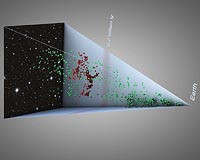 |
Boston MA (SPX) Nov 11, 2009 In celebration of the International Year of Astronomy 2009, NASA's Great Observatories - the Hubble Space Telescope, the Spitzer Space Telescope, and the Chandra X-ray Observatory - have collaborated to produce an unprecedented image of the central region of our Milky Way galaxy. In this spectacular image, observations using infrared light and X-ray light see through the obscuring dust and reveal the intense activity near the galactic core. Note that the center of the galaxy is located within the bright white region to the right of and just below the middle of the image (labeled Sagitarrius A when you roll your mouse over the above composite image). The entire image width covers about one-half a degree, about the same angular width as the full moon. Each telescope's contribution is presented in a different color: + Yellow represents the near-infrared observations of Hubble. They outline the energetic regions where stars are being born as well as reveal hundreds of thousands of stars. + Red represents the infrared observations of Spitzer. The radiation and winds from stars create glowing dust clouds that exhibit complex structures from compact, spherical globules to long, stringy filaments. + Blue and violet represents the X-ray observations of Chandra. X-rays are emitted by gas heated to millions of degrees by stellar explosions and by outflows from the supermassive black hole in the galaxy's center. + The bright blue blob on the left side of the full field image is emission from a double star system containing either a neutron star or a black hole. When these views are brought together, this composite image provides one of the most detailed views ever of our galaxy's mysterious core. Share This Article With Planet Earth
Related Links Chandra X-ray Observatory Astronomy News from Skynightly.com
 Shedding Light On The Cosmic Skeleton
Shedding Light On The Cosmic SkeletonParis, France (SPX) Nov 04, 2009 Astronomers have tracked down a gigantic, previously unknown assembly of galaxies located almost seven billion light-years away from us. The discovery, made possible by combining two of the most powerful ground-based telescopes in the world, is the first observation of such a prominent galaxy structure in the distant Universe, providing further insight into the cosmic web and how it formed. ... read more |
|
| The content herein, unless otherwise known to be public domain, are Copyright 1995-2009 - SpaceDaily. AFP and UPI Wire Stories are copyright Agence France-Presse and United Press International. ESA Portal Reports are copyright European Space Agency. All NASA sourced material is public domain. Additional copyrights may apply in whole or part to other bona fide parties. Advertising does not imply endorsement,agreement or approval of any opinions, statements or information provided by SpaceDaily on any Web page published or hosted by SpaceDaily. Privacy Statement |